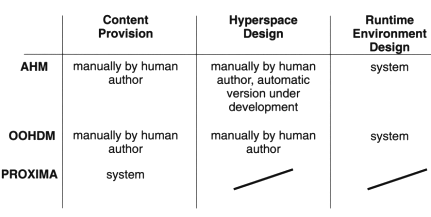Electronic Proceedings of the
ACM Workshop on Effective Abstractions in Multimedia
November 4, 1995
San Francisco, California
Introductory Slides for Session 2: Presentation -- General Models and Issues
- Elisabeth André
-
- German Research Center for Artificial Intelligene
- Stuhlsatzenhausweg 3
- D-66123 Saarbrücken
- Germany
- andre@dfki.uni-sb.de
-
http://www.dfki.uni-sb.de/~andre
Abstract
A comparising overview of the kinds of abstraction handled in the
papers of section 2
- AHM
- Using the Amsterdam Hypermedia Model for
Abstracting Presentation Behavior
Lynda Hardman, Dick C.A. Bulterman
CWI, The Netherlands
- PROXIMA
- Since Less is Often More:
Methods for Stylistic Abstractions in 3D-Graphics
Antonio Krüger, Thomas Rist
DFKI GmbH Saarbrücken, Germany
- OOHDM
- Abstraction, Composition and Lay-Out
Definition Mechanisms in OOHDM
Daniel Schwabe, Gustavo Rossi, Simone D.J. Barbosa
Pontificia Universidade Católica, Brazil
- Abstracting from a Specific Presentation Behavior
- Model for describing different hypermedia presentations and user interactions (AHM)
- Model-based approach for building hypermedia applications (OOHDM)
- Generating Presentations of Different Levels of Abstraction
- Methods for Stylistic Abstractions in 3D-Graphics (PROXIMA)
- Abstracting from a Specific Presentation Behavior
- Compare the expressive power of various authoring systems and document formats (descriptive approach)
- Support incremental design, evolution and reuse (operational approach)
- Generating Presentations at Different Levels of Abstraction
- Cope with mental resources of human viewers by focusing on relevant information
- Cope with computational resource limitations
- Low-bandwidth communication channels (e.g. screen resolution, network capacity)
- Realtime applications (Virtual Realities)
- AHM:
explicit representation of the document structure (structural, spatial and temporal relations)
- PROXIMA:
explicit representation of the contents and the form of a presentation (Which objects are visible, discriminable etc.)
- OOHDM:
explicit representation of all design decisions
The structure of a hypermedia document is built up of components connected by links via anchors (see the Dexter model [Halasz/Schwartz 94]).
- AHM:
Anchors, links, synchronization arcs
Organization : composite components
- OOHDM:
Nodes, links, access structures
Organization: navigational contexts
- PROXIMA:
Anchors correspond to parts of a graphics.
Links are dynamically expanded
- from a detailed to a less detailed graphics (via performing an abstraction process)
- from a less detailed to a more detailed graphics (via undoing abstraction steps)
- AHM:
Channels encode high-level presentation attributes, such as font and style for a text, or volume for an audio channel
- OOHDM:
Abstract Data Views (ADVs) comprise a set of attributes which define the perception properties of an object and the set of events it can handle
- PROXIMA:
Presentation knowledge is encoded by design strategies, graphics generator provides an explicit representation of its encodings via so-called picture descriptions

- [Andre/Rist 95a]
-
Elisabeth André, and Thomas Rist.
"Generating Coherent Presentations Employing Textual and Visual Material."
Artificial Intelligence Review 9,
pp. 147-165, 1995.
Online document available at URL
http://www.dfki.uni-sb.de/~andre/papers/ai-review.ps.
- [Andre/Rist 95b]
-
Elisabeth André, and Thomas Rist.
"Research in Multimedia Systems at DFKI."
Artificial Intelligence Review 9,
pp. 81-84, 1995.
Online document available at URL
http://www.dfki.uni-sb.de/~andre/papers/site-des.ps.
- [Andre/Rist 95c]
-
Elisabeth André, and Thomas Rist.
"Towards a New Generation of Hypermedia Systems: Extending Automated Presentation Design for Hypermedia."
submitted,
1995.
- [Feiner/McKeown 91]
-
S.K. Feiner, and K.R. McKeown.
"Automating the Generation of Coordinated Multimedia Explanations."
IEEE Computer 24(10),
pp. 33-41, 1991.
- [Halasz/Schwartz 94]
-
F. Halasz, and M. Schwartz.
"The Dexter Hypertext Reference Model."
Communications of the ACM 37(2),
pp. 30-39, 1994.
- [Hardman et al. 94]
-
Lynda Hardman, Dick C.A. Bulterman, and Guido van Rossum.
"The Amsterdam Hypermedia Model: Adding Time and Context to the Dexter Model."
Communications of the ACM 37(2),
pp. 50-62, 1994.
- [Hardman/Bulterman 95]
-
Lynda Hardman and Dick C.A. Bulterman.
"Towards the Generation of Hypermedia Structure."
Proceedings of First International Workshop on Intelligence and
Multimodality in Multimedia Interfaces,
Edinburgh, 1995.
- [Isakowitz et al. 95]
-
Tomas Isakowitz, Edward A. Stohr, and P.Balasubramanian.
"RMM: A Methodology for Structured Hypermedia Design."
Communications of the ACM 38(8),
pp. 34-44, 1995.
- [Maybury 93]
-
M. Maybury.
"Planning Multimedia Explanations Using Communicative Acts."
Intelligent Multimedia Interfaces,
M. Maybury (ed.), pp. 14-60, 1993.
- [Schwabe/Rossi 95]
-
Daniel Schwabe, and Gustavo Rossi.
"The Object-Oriented Hypermedia Design Model."
Communications of the ACM 38(8),
pp. 45-46, 1995.
